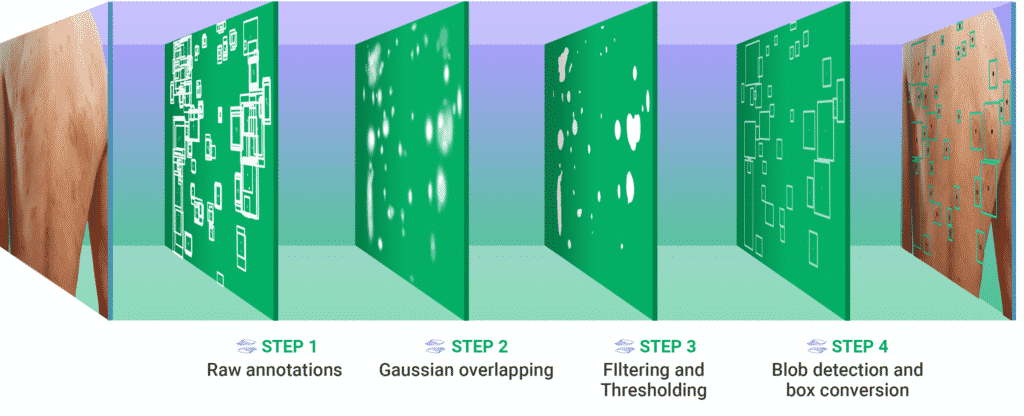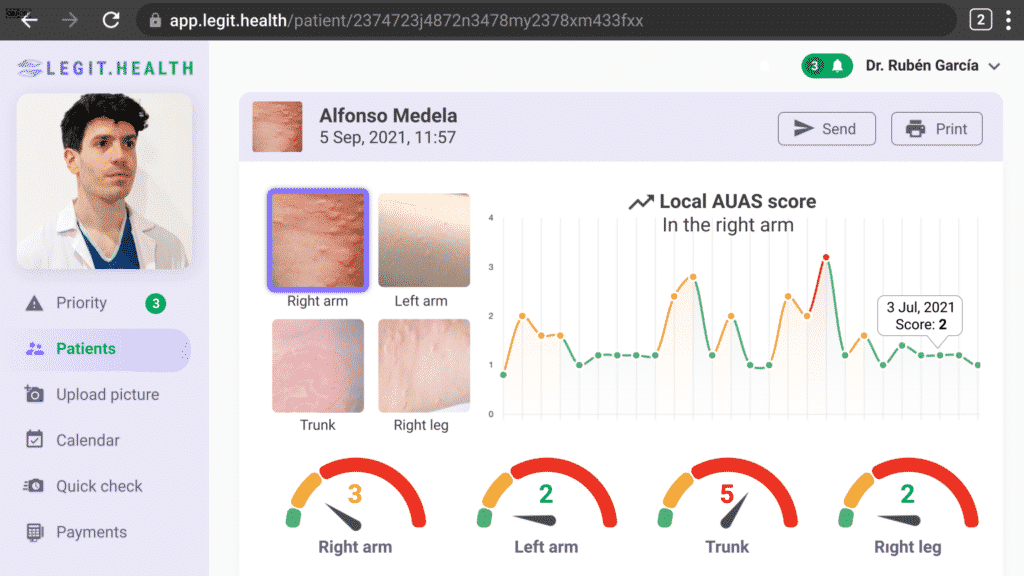AUAS7: the game-changing outcome measure for Urticaria
Introduction
The future of measuring urticaria is now within hands reach. Measuring the score of urticaria and hives is easier and more reliable than ever thanks to Legit.Health's revolutionary AUAS (Automatic Urticaria Activity Score). The researchers have developed a tool that processes smartphone images and automatically analyses them using the same criteria as the UAS7.
Is widely known that objective, reliable, and precise outcome measures are key to the practice of evidence-based medicine. The UAS7 has proven to have the best measurement properties and is the most recommended for use in clinical trials when considering urticaria.
Explanation of how the artificial intelligence identifies hives in urticaria
images.
This post refers to a scientific publication published in the Journal of Investigative Dermatology (JID) Innovations. We encourage you to read the whole publication, embedded below. Mac Carthy, T., Hernández Montilla, I., Aguilar, A., García Castro, R., González Pérez, A. M.,
Vilas Sueiro, A., Vergara de la Campa, L., Alfageme, F., & Medela, A. (2024). Automatic
Urticaria Activity Score: Deep Learning-Based Automatic Hive Counting for Urticaria Severity
Assessment. In JID Innovations (Vol. 4, Issue 1, p. 100218). Elsevier BV.
https://doi.org/10.1016/j.xjidi.2023.100218
UAS7: the foundation of the diagnosis of urticaria
Urticaria has a very variable nature, even when it becomes a chronic disease. It causes rashes that vary in intensity and extension, and symptoms may vary from one moment to another. For this reason, measuring the severity is very tricky. To achieve this goal, the most used scoring system for this condition is the UAS7. Indeed, The international EAACI/GA2LEN/EDF/WAO guidelines for urticaria recommend the use of the UAS in clinical practice to determine disease activity and response to treatment.
The Urticaria Activity Score (UAS) was developed as a simple scoring system that takes into account the number of wheals and the intensity of the itching. Despite these variables being recorded by the patients, many considered that their condition could not be accurately described by the isolated analysis of their state in one day.
Thus the UAS7 was born. The UAS was created in 2006 by a group of doctors led by a German doctor called Torsten Zuberbier. It also came with a version that aggregates all the UAS scores of a patient over seven days, which allows the doctor to better understand the full extension of the disease.
The main shortcoming of UAS7
Despite not being appropiate for all variants of urticaria, the UAS7 is still considered the gold standard for the assessment of the severity of chronic urticaria.
The UAS7 records, over 7 consecutive days, the daily number of wheals and the intensity of itch. It is the guideline-recommended gold standard for measuring disease activity in CSU...
This system's main weakness, like many other PROM (Patient Reported Outcome Meassures), is its reliance on the patient to recollect the data. A patient who not only lacks the medical expertise of a doctor but is suffering from a debilitating and stressful condition that might push them into exaggerating their symptoms to try and get better attention.
Consistency is another main issue. Is a known fact that many patients will forget to fill in their UAS for the day, leading to incomplete data. But this has nothing to do with the inherent clinical properties of UAS7, and that's why it was chosen as the base for Legit.Health's revolutionary AUAS7.
Do you want to see the clinical AI technology in action?
How do we know if a scoring system is good?
When it comes to dermatological assessments, the effectiveness of a scoring system is paramount. But what exactly makes a scoring system reliable and useful? Through scientific consensus, several key factors have been identified that contribute to the robustness of these systems. Let's delve into these crucial elements:
- Ease of Use: This factor considers whether the system can be applied effortlessly within the constraints of time and financial resources. A user-friendly system is crucial for widespread adoption in clinical settings.
- Sensitivity to Change: An effective scoring system must be capable of detecting clinically meaningful changes over time. This sensitivity ensures that any progress or deterioration in a patient's condition is accurately captured.
- Interobserver Reliability: This refers to the consistency of the results when different observers use the scoring system. High interobserver reliability means different clinicians will arrive at similar conclusions, enhancing the system's credibility.
- Intra-observer Variability: This looks at the consistency of results when the same observer uses the scoring system multiple times. Low intra-observer variability indicates that the system provides stable results, irrespective of repeated assessments by the same clinician.
- Interpretability: A practical scoring system should provide meaningful qualitative interpretations of its scores, like categorizing the severity of a condition as mild, moderate, or severe.
These criteria not only ensure the scoring system's effectiveness but also its applicability and reliability in diverse clinical scenarios.
Adapted from "Methods and definitions to rate the quality of outcome measures". Schmitt, J., Langan, S., Deckert, S., Svensson, A., von Kobyletzki, L., Thomas, K., & Spuls, P. (2013). Assessment of clinical signs of atopic dermatitis: A systematic review and recommendation. Journal of Allergy and Clinical Immunology, 132(6), 1337--1347. doi:10.1016/j.jaci.2013.07.008.
Why AUAS7 is the best tool to determine the severity of chronic urticaria
Legit.Health is the revolutionary Clinical Data and Communication tool for Next-generation dermatologists that triples the empowerment of patients.
In cases like chronic urticaria, where the data recollection is in the hands of the patients, having the best tool to ensure that the recorded information is objective, accurate and reliable is of the utmost importance. This becomes especially true in clinical trials, where the precision of the data can make the difference between a successful study and a muddy one.
Legit.Health's algorithms automatically grade lesions just by looking at smartphone images and reduce the small patient-reported outcome measures (PROMs) to the bare minimum, using them only to record variables like itchiness that cannot be seen in a photograph. In other words: the tool will automatically fill in most of the dermatology scoring systems, such as PASI, SCORAD, IHS4, GAGS, and of course, UAS.
Explanation of how the artificial intelligence identifies hives in urticaria
images.
The main goal of AUAS7 is to provide a tool to record data precisely and consistently for routine evaluations and clinical studies.
Caption of a full report from the CADx system. The chart at the top right shows the evolution of
the urticaria, by plotting the AUAS scores across time.
1. Is easy to use
Ease of use is paramount in our modern society, but especially in a case like the severity assessment of chronic urticaria.
Thanks to the revolutionary deep learning algorithm developed by Legit.Health and the design of its interface, the patients won't need to count the number of wheals, nor have to remember to take the measurement, as a notification in their smartphone will remind them to take a simple picture.
This picture is analyzed by the clinically validated algorithm and its results are sent to the doctor, who benefits not only from the consistency of the data generated by this process but also easier the job of monitoring rashes and the development of the disease.
Traditional consultation
8 medical acts per hour
With Legit.Health
52 medical acts per hour
After all, communication between the doctor and the patient is one of the cornerstones of medicine, and it should be easy.
2. Is more precise and reliable
Legit.Health's tool analyzes the pathologies using a validated scoring system that has both the lowest MID (Minimal important Difference) and is sensible to the lowest LDC (Lowest Detectable Change), which means the algorithm analyzes every image with more precision and attention to detail than any human observer would.
In clinical trials, quantification of the disease is critical to measure the efficacy of an investigational treatment by comparing the severity of disease before therapy to that measured after treatment.
Furthermore, it has a higher validity and reliability while maintaining comparable clinimetric properties, thanks to the intrinsic functioning of computer vision algorithms.
3. Eliminates the intrinsic variability of a PROM
Due to the algorithmic nature of AUAS7, the intra-observer variability is eliminated completely and without doubt, as every image and calculation is neatly stored in the app's database.
After all, when calculating the traditional UAS, doctors are relying on the ability of the patient to count the wheals. These patients, who have no medical training, are under pressure to give their doctor critical information to develop their treatment, increasing their stress and adding even more inconvenience to their daily lives.
This kind of measuring approach leads to a lot of variability that, with the right tool, is easy to avoid.
4. Allows the patient to report rashes in real-time
Thanks to the tool developed by Legit.Health, a patient no longer needs to wait for a doctor's appointment to report on a flare-up of their affection.
The app allows the patient to take a simple picture with their smartphone, and send it to an algorithm that will automatically count the number of wheals. Afterwards, the app runs a simple questionnaire about the itchiness and quality of life and sends all the information to the doctor managing the case.
In less than 23 seconds, the rash can be reported, avoiding unsatisfactory visits to the doctor where the severity of the flare has reduced by the time the patient arrives at the medical centre.
Do you want to see the clinical AI technology in action?
5. Empowers the patient to take part in its own treatment
One of the most reported misuses of the UAS7 is due to the inconvenience of this scoring system for the life of a patient that has to not only deal with an incapacitating and stressful condition but to remember to apply the scoring system in order to get good care from their doctors.
The revolutionary app developed by Legit.Health makes sure that haphazardly filling out the UAS7 the day before the visit to the doctor has less of an excuse.
Thanks to daily notifications and reminders, its accessibility, and its ease of use, Legit.Health makes recording data with the help of your patients easier than ever, by making them become an active part of their treatment and empowering them by improving the ever-so-important communication with their doctor.
6. Makes the data easy to access and interpret
Last but not least, Legit.Health's interface provides access to all the relevant information about the patient in an easy-to-read manner.
Every data derived from the AUAS7 is clearly displayed on the screen, showing the severity of the affection and the different factors considered by the algorithm when analyzing the image and their scores.
The app also provides a handy graff that shows the evolution of the disease across time and makes following the healing process and the effectiveness of the treatment really easy.
Do you want to see the clinical AI technology in action?
Conclusion
The revolutionary AUAS7 represents the future of dermatology. Allowing doctors across the globe to practice evidence-based medicine by using the best tools during the disease diagnosis while improving the effective communication between doctor and patient.
Thanks to Legit.Health, doctors across the globe can improve their correct diagnosis rate by 23% and make treatment easier to follow for the patient by making them active participants in their own recovery.
We cannot improve what we cannot measure, and thanks to AUAS7 and Legit.Health the future of the study and treatment of urticaria is brighter than ever.
Get access now
Get started
AI-powered dermatology validated by peer-reviewed research. Trusted by leading hospitals across Europe. Fill in the form to see how our CE-marked platform can transform your practice.





